A gallery of Scott Lund's most important,
beautiful, and intriguing imagery
Self-evident proof that Da Vinci's Mona Lisa personifies Bramante's Tempietto
beautiful, and intriguing imagery
Self-evident proof that Da Vinci's Mona Lisa personifies Bramante's Tempietto

Self-evident proof that Leonardo da Vinci painted the Mona lisa as a personification of Bramante's Tempietto in Rome. The Prado copy of the painting provides corroboration detail that the partial pillars on the wall behind the figure, and the chair she sits on, were directly taken from the architecture of the chapel. The peculiar "double-bellied" balusters are seen as the spindles of the armrest, while the bases of the pillars, and the top and bottom ornamentation of the stylobate, are nearly an exact match. Da Vinci and his good friend Bramante created their works together to express the religious doctrine of the "Two Faces of the Soul." On September 10, 2011, Scott Lund held a public press conference at the ancient Roman Forum announcing the connection between the Mona Lisa and the Tempietto. The iconic Renaissance structure occupies the vantage point on top of the Janiculum hill from where the right side landscape of the painting is viewed.

Metaphoric quantum musings: In this 4-square comparison, Scott Lund makes the artistic statement that 2+2+2+2+2+2=1. Leonardo da Vinci's Mona Lisa, his Vitruvian Man, Bramante's Tempietto, and the Roman Sun god Janus, are all linked together such that each different pairing of squares is unique, yet equal in symbolic importance to all the rest. All possible pairings then result in one complete understanding of meaning. The whole picture can also be considered synergistically, thus its symbolic meaning exceeds the sum of its four separate parts: 1+1+1+1=<4
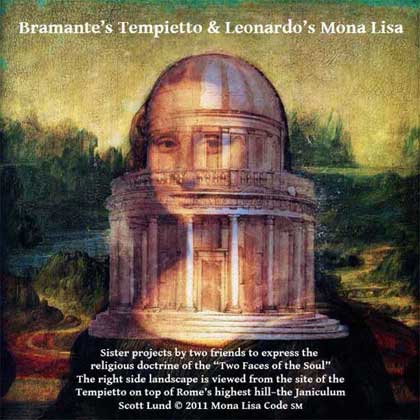
Above the features of the Mona Lisa line up with the basic symmetry of the Tempietto of Bramante. Especially worth noting is the basic shape of the top of the head as it follows the contour of the dome, as well as the part in the hair which mimics its curved architectural lines. The Mona Lisa was apparently intended to personify Bramante's elegant chapel, and vice versa. The drawing is thought to have been done by Bramante himself, and so it presumably served as the inspiration for Da Vinci's composition of the Mona Lisa.
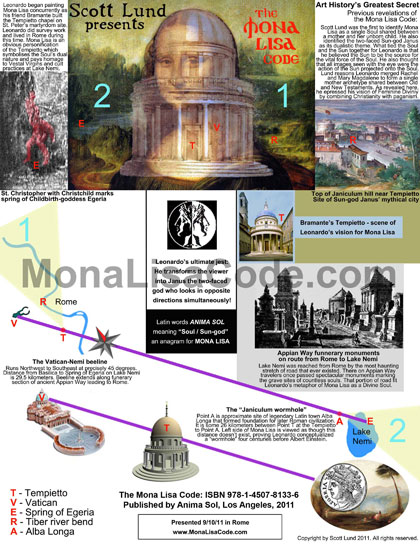
Leonardo da Vinci began painting the Mona Lisa concurrently as his good friend Donato Bramante built the Tempietto chapel on St. Peter's martyrdom site atop the Janiculum hill in Rome. Leonardo did survey work and lived in Rome during the time. The Mona Lisa is an obvious personification of the Tempietto, which symbolized the Soul's dual nature and pays homage to the temples of the Vestal Virgins of Rome.
Running Northwest to Southwest at precisely 45 degrees, the Vatican-to-Lake-Nemi survey line extended a distance of 29.5 kilometers. The line was roughly paralleled by the funerary section of the Appian Way, where travelers once passed spectacular monuments marking the grave sites of countless souls.
Scott Lund was the first to identify the Mona Lisa as a single Soul shared between a mother and her unborn child. He also identified the two-faced Sun-god Janus as its dualistic theme. What tied the Soul and the Sun together for Da Vinci was that he believed the Sun to be the source for the vital force of the Soul. He also thought that all images seen with the eye were the action of the Sun projected on the Soul.
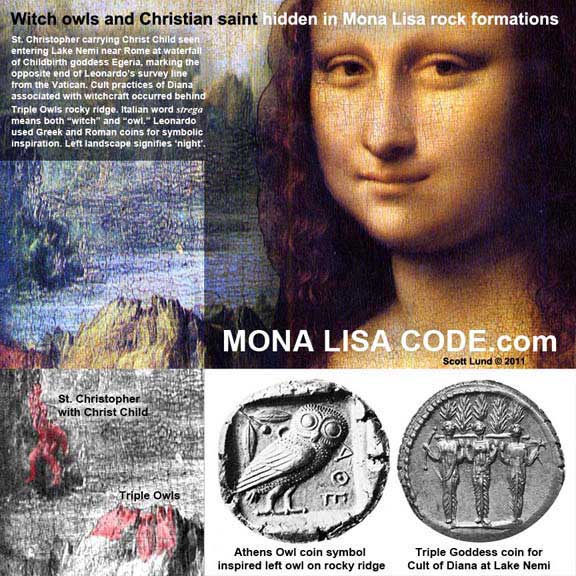
Symbolic evidence of witchcraft is seen associated with the cult site of the Roman goddess Diana at Lake Nemi. On the left-side landscape of the Mona Lisa, disguised as part of a rock formation, St. Christopher carrying the Christ Child on his shoulders is seen at the precise location where the waterfall of the Childbirth goddess Egeria emptied into the lake. This point marked the opposite end of a survey line that Leonardo da Vinci established at the center of the dome of St. Peter's basilica at the Vatican. Another rock formation appears as three owls, which seems to have represented the Triple-goddess figure, depicted above on a coin. The Italian word strega meant both "witch" and "screech owl," and the triple-owl figure may refer to the witch triad known as "Trivia," which was identified by name with both Diana and Hecate.

The mysterious nature of Bramante's elegant chapel is brought out in this brooding artistic interpretation by Scott Lund. The Tempietto is protected by the Royal Academy of Spain in Rome, or Real Academia de Espana en Roma.
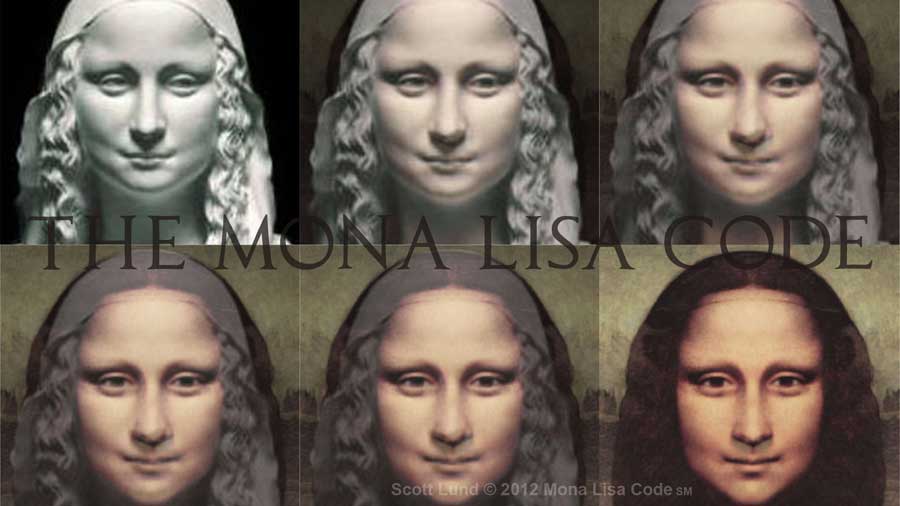
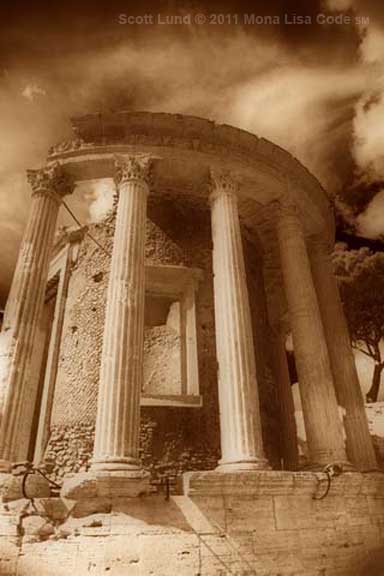
Bramante's Tempietto was inspired by the circular temples of Vesta, and in particular by the beautiful one perched at the top of a cliff at the town of Tivoli, close to Rome. (Photo by Scott Lund)
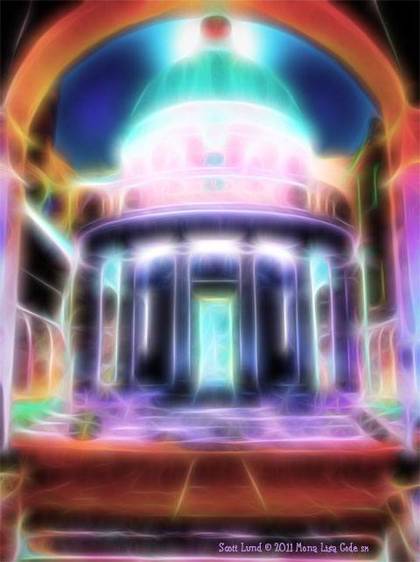
This surreal fantasy vision of the Tempietto is likened to that of a dream. The colorful rendering has appealed to many followers of the Mona Lisa Code.
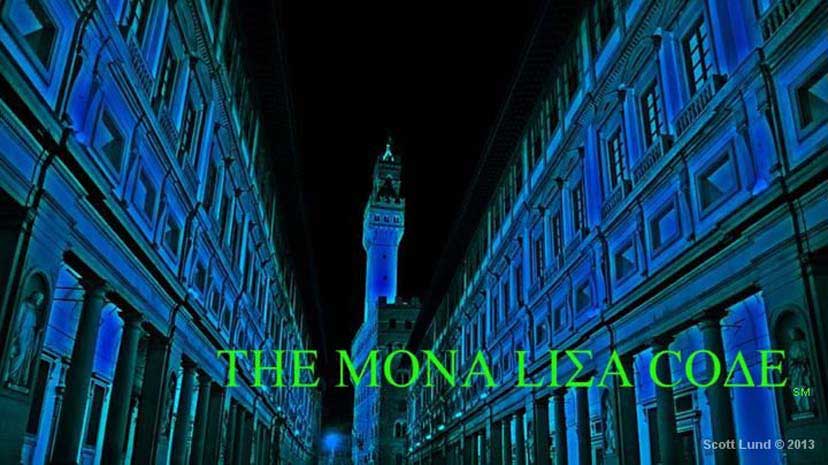
Shrouded Florentine streets,
Seen through the not-so-naked eye,
Pulsing like arteries of archaic stone,
Greek letters hint at their distant origin.